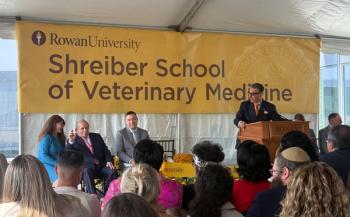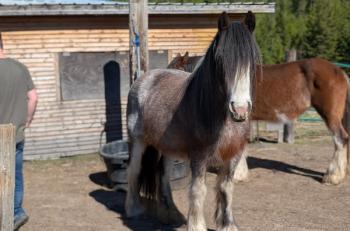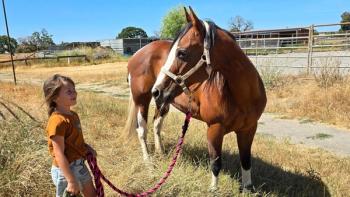
Rhodococcus equi infection in foals: immunity and clinical signs (Proceedings)
Among equids, R. equi infections occur almost exclusively among foaIs; infected adult horses generally have an underlying immunodeficiency, and human cases of R. equi are most commonly reported among persons infected with HIV or with other forms of immunosuppression such as that induced by drugs in transplant recipients and those receiving chemotherapy.
IMMUNITY TO R. EQUI
Among equids, R. equi infections occur almost exclusively among foaIs; infected adult horses generally have an underlying immunodeficiency, and human cases of R. equi are most commonly reported among persons infected with HIV or with other forms of immunosuppression such as that induced by drugs in transplant recipients and those receiving chemotherapy. These findings suggest that there is a maturational defect in the immune system of foals. The nature of this deficiency remains elusive. It is clear that immunity to R. equi in foals is complex and involves innate and adaptive immune responses.
Innate immune responses are critical for protection against infections in neonates because there is a lag until an adaptive immune response will be developed. Epidemiological and clinical evidence exists that foals become infected early in life with R. equi,1,2 such that innate immunity would be expected to be important for protection. Foal neutrophils can kill R. equi 3-5 and play a key role in protecting mice against experimental infection with R. equi.6 Neutrophils of newborn foals have been documented to have some functional deficits relative to those of older foals, including cytokine expression and bactericidal capacity in some foals.6,7 Neutrophil concentrations were significantly lower in foals that subsequently developed R. equi pneumonia than in foals matched for age and farm.8 Although neutrophils are key effectors of innate immunity, other cells also play a role. Macrophages and peripheral blood mononuclear cells express cytokines following stimulation with R. equi.9-11 The role of epithelial cells in innate immunity to R. equi is beginning to be studied. In brief, innate immune responses result both in direct killing of R. equi and likely contribute to directing the adaptive immune response towards a T helper lymphocyte type 1 (Th1) response.
In terms of adaptive immunity, evidence of a role for both humoral and cell-mediated immune responses exists. Prophylactic transfusion of foals with hyper-immune plasma is partially effective in reducing disease incidence. Purified antibodies against the virulence-associated proteins A and C (VapA and VapC) protected foals against experimental challenge.12 Opsonization with antibodies from commercial hyperimmune plasma enhanced the oxidative burst of neutrophils and macrophages, and increased TNF-α production by macrophages.13 Moreover, opsonization results in killing of R. equi by equine neutrophils, and enhances phagocytosis and killing by macrophages.3,4,9 There is conflicting evidence regarding the efficacy of vaccination of mares to protect foals,14-17 with some data to suggest the potential for maternal transfer of immunity to foals.
Rhodococcus equi is a facultative intracellular pathogen. Evidence exists that cell-mediated immunity is critical for protecting against intracellular infections. Roles for both CD4+ and CD8+ T lymphocytes have been described in mice and horses, with CD4+ playing a dominant role in mice.18-22 In horses, CD8+ T cells recognize and kill R. equi-infected macrophages in an MHC class-I unrestricted manner.23,24 These data suggest that lipid moieties in the cell wall recognized by CD1 may be targets for protective immune responses. Indeed, macrophages pulsed with R. equi lipids are lysed by CD8+ T cells in an MHC I-unrestricted manner.25 There is some controversy regarding the extent to which adaptive immune responses are impaired in foals, but most results suggest that deficiencies in adaptive immune responses exist in foals.
The presumed route of infection for R. equi pneumonia is by inhalation. Thus, respiratory mucosal immunity is likely to play a role in protection. Mucosal immune responses at a surface may be disseminated to other surfaces. The fact that oral vaccination of young foals with R. equi can protect against subsequent intrabronchial challenge suggests a critical role for mucosal immunity.26,27
In summary, immunity to R. equi is complex and multi-faceted. This complexity coupled with limitations of neonatal immune responses represent important challenges for developing an effective vaccine against R. equi.
CLINICAL SIGNS OF R. EQUI INFECTION IN FOALS
The classical clinical signs of R. equi pneumonia have been well described.28 Signs occur in foals from 3 weeks to 6 months of age, although signs are most common among foals aged 3 weeks to 3 months of age. The disease is generally insidiously progressive such that foals may have extensive pulmonary damage before clinical signs of increased effort or rate of respirations, coughing, or nasal discharge are detected. It is the author's impression that the severity of clinical signs and pathologic lesions appear to be diminishing as a result of widespread use of screening tests for earlier detection of disease.
Extrapulmonary disorders (EPDs) attributed to infection with R. equi occur. To the author's knowledge, the frequency of EPDs among foals with R. equi infections from breeding farm populations has not been reported. Among 150 foals with R. equi infection admitted to Texas A&M University's Veterinary Teaching Hospital, 115 (77%) were documented as having EPDs.29 A total of 39 EPDs were identified. The most common EPDs were diarrhea, presumed immune-mediated synovitis, ulcerative enterotyphlocolitis, intra-abdominal abscessation, and intra-abdominal lymphadenitis. Interestingly, less than half the foals determined to have ulcerative enteritis or typhlocolitis developed diarrhea. EPDs may be the first clinical signs noted by owners (such as effusion of multiple joints), and EPDs may result in the foal's demise despite resolution of R. equi pneumonia. Some EPDS are only recognized post-mortem. Enhanced recognition of the frequency with which EPDs occur may lead to earlier recognition of the EPDs or to R. equi disease. All foals with R. equi pneumonia should be evaluated for evidence of EPDs, although some may be identified only post-mortem.
REFERENCES
Horowitz ML, Cohen ND, Takai S, et al. Application of Sartwell's model (logarithmic-normal distribution of incubation periods) to age at onset and age at death of foals with Rhodococcus equi pneumonia as evidence of perinatal infection. J Vet Int Med 2001;15:171-175.
Chaffin MK, Cohen ND, Martens RJ. Chemoprophylactic effects of azithromycin against Rhodococcus equi-induced pneumonia among foals at equine breeding farms with endemic infections. J Am Vet Med Assoc 2008;232:1035-1047.
Hietala SK, Ardans AA. Neutrophil phagocytic and serum opsonic response of the foal to Corynebacterium equi. Vet Immunol Immunopathol 1987;14:279-294.
Martens RJ, Martens JG, Renshaw HW, Hietala SK. Rhodococcus equi: equine neutrophil chemiluminescent and bactericidal responses to opsonizing antibody. Vet Microbiol 1987;14:277-286
Martens JG, Martens RJ, Renshaw HW. Rhodococcus (Corynebacterium) equi: bactericidal capacity of neutrophils from neonatal and adult horses. Am J Vet Res 1988; 49:295-299.
Martens RJ, Cohen ND, Jones SL, Moore TA, Edwards JF. Protective role of neutrophils in mice experimentally infected with Rhodococcus equi. Infect Immun 2005;73:7040-7042.
Nerren JR, Martens RJ, Payne S, Murrell J, Butler JL, Cohen ND. Age-related changes in cytokine expression by neutrophils of foals stimulated with virulent Rhodococcus equi in vitro. Vet Immunol Immunopathol 2009;127:212-219.
Chaffin MK, Cohen ND, Martens RJ, Edwards RF, Nevill M, Smith R 3rd.
Hematologic and immunophenotypic factors associated with development of Rhodococcus equi pneumonia of foals at equine breeding farms with endemic infection. Vet Immunol Immunopath 2004;100:33-48.
Darrah PA, Monaco MCG, Jain S, Hondalus MK, Golenbock DT, Mosser DM. Innate immune responses to Rhodococcus equi. J Immunol 2004;173:1914-1924.
Giguère S, Prescott JF. Cytokine induction in murine macrophages infected with virulent and avirulent Rhodococcus equi. Infect Immun 1998;66:1848-1854.
Liu T, Nerren J, Liu M, Martens R, Cohen N. Basal and stimulus-induced cytokine expression is selectively impaired in peripheral blood mononuclear cells of newborn foals. Vaccine 2009;27:674-683.
Hooper-McGrevy KE, Giguère S, Prescott JF. Evaluation of equine immunoglobulin specific for Rhodococcus equi virulence-associated proteins A and C for use in protecting foals against Rhodococcus equi-induced pneumonia. Am J Vet Res 2001;62:1307-1313.
Dawson DR, Flaminio MJBF, Nydam D, Graham JE, Cynamon M, Divers TJ. Opsonization of Rhodococcus equi with high antibody plasma decreases bacterial viability and promotes phagocyte activation, In Proceedings, 27th Annual Veterinary Medical Forum, Montreal, Quebec, 2009.
Martens RJ, Martens JG, Fiske RA. Failure of passive immunization by ingestion of colostrum from immunized mares to protect foals against Rhodococcus equi pneumonia. Equine Vet J 1991;12(Suppl):19-22.
Muller NS, Madigan JE. Methods of implementation of an immunoprophylaxis program for the prevention of Rhodococcus equi pneumonia: results of a 5-year field study. Proceedings. 38th Annual Convention of the American Association of Equine Practitioners 1992;193-201.
Becu T, Polledo G, Gaskin JM. Immunoprophylaxis of Rhodococcus equi pneumonia in foals. Vet Microbiol 1997;56:193-204.
Cauchard J, Sevic C, Ballet JJ, Taouji S. Foal IgG and opsonizing anti-Rhodococcus equi antibodies after immunization of pregnant mares with a protective VapA candidate vaccine. Vet Microbiol 2004;104:73-81.
Kanaly ST, Hines SA, Palmer GH. Cytokine modulation alters pulmonary clearance of Rhodococcus equi and development of granulomatous pneumonia. Infect Immun 1995;63:3037-3041.
Kanaly ST, Hines SA, Palmer GH. Transfer of a CD4+ Th1 cell line to nude mice effects clearance of Rhodococcus equi from the lung. Infect Immun 1996;64:1126-1132.
Ross TL, Balson GA, Miners JS, Smith GD, Shewen PE, Prescott JF, Yager JA. Role of CD4+, CD8+ and double negative T-cells in the protection of SCID/beige mice against respiratory challenge with Rhodococcus equi. Can J Vet Res 1996;60:186-192.
Hines SA, Stone D, Hines MT, Alperin DC, Knowles DP, Norton L, Hamilton MJ, Davis WC, McGuire TC. Clearance of virulent but not avirulent Rhodococcus equi from the lungs of adult horses is associated with intracytoplasmic gamma interferon production by CD4+ and CD8+ T lymphocytes. Clin Diagn Lab Immunol 2003;10:208-215.
Nordmann P, Ronco E, Nauciel C. Role of T-lymphocyte subsets in Rhodococcus equi infection. Infect Immun 1992;60:2748-2752.
23.Patton KM, McGuire TC, Hines MT, Mealey RH, Hines SA. Rhodococcus equi-specific cytotoxic T lymphocytes in immune horses and development in asymptomatic foals. Infect Immun 2005;73:2083-2093.
Patton KM, McGuire TC, Fraser DG, Hines SA. Rhodococcus equi-infected macrophages are recognized and killed by CD8+ T lymphocytes in a major histocompatibility complex class I-unrestricted fashion. Infect Immun 2004;72:7073-7083.
Harris SP, Fujiwara N, Mealey RH, et al. Identification of Rhodococcus equi lipids recognized by host cytotoxic T lymphocytes. Microbiology 2010;156:1836-1847.
Chirino-Trejo JM, Prescott JF, Yager JA. Protection of foals against experimental Rhodococcus equi pneumonia by oral immunization. Can J Vet Res 1987;51:444-447.
Hooper-McGrevy KE, Wilkie BN, Prescott JF. Virulence-associated protein-specific serum immunoglobulin G-isotype expression in young foals protected against Rhodococcus equi pneumonia by oral immunization with virulent R. equi. Vaccine 2005;23:5760-5767.
Giguère S and Prescott JF. Clinical manifestations, diagnosis, treatment, and prevention of Rhodococcus equi infection in foals. Vet Microbiol 1997;56:313-334.
Reuss SM, Chaffin MK, Cohen ND. Extrapulmonary disorders associated with Rhodococcus equi infection in foals: 150 cases (1987-2007). J Am Vet Med Assoc 2009;235:855-863.
Newsletter
From exam room tips to practice management insights, get trusted veterinary news delivered straight to your inbox—subscribe to dvm360.






